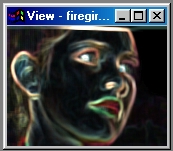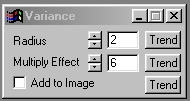| This is a child page. You can use Parent in the quick nav bar at the top or the bottom of the page to navigate directly back to the parent of this page. Some child pages are more than one level deep, and in that case will require more than one Parent click to reach the outermost document level. |
§ 16.61 - Variance
| Quick Reference to Scripting Command |
| a=VARIANCE(multiply, width, ADDITIVE) |
| Items in CAPS are 0/1 or ranges with more options than just 0/1. Ranges other than 0/1 are indicated by brackets, such as [0-2]. |

 Original Image |
 Variance with setting shown |
The Variance operation measures the difference between a pixel and its neighbors. These variance values are then assigned color values and applied to the image. This operation can produce an interesting color effect called "Neonize", and can also be used to detect high frequency noise in an image. You can control the radius of pixels that are considered and the amount of the effect.
§ 16.61.1 - Variance Controls
§ 16.61.1.1 - Trends
Operator dialog controls that have a Trend button next to them offer animation functionality. Trend allows you to set that variable over a set of frames. Each frame of the animation can be thought of as a slice of time. The trends allow you to alter some, all, or none of the variables for a particular time slice. Variables that have multiple states can be set to any of a number of values in the trend. Variables that are either on or off can only have an on or off value in the trend. You will notice that the trend graphs have equidistantly spaced vertical lines. Each of these lines represents a frame in the animation. The number of frames can be altered using Sequence controls... in the TimeLine pull down menu. Animation lengths of 100 - 999 frames will be represented with a vertical bar being 10 frames, and animation length greater than 1000 frames will have a vertical bar for every 100 frames. Click here to view more information on Trends.
§ 16.61.1.2 - Radius
The Radius control is used to specify the number of pixels that are considered for each pixel in the region. This setting can range between 1 and 10 pixels. It is important to remember that as the number of pixels that are evaluated for each pixel in the region increases, so will the computational time needed to complete the effect. For example, a radius of 10 pixels takes 100 times longer to complete than a radius of 1 pixel. This control is set using the slide gadget or text entry field.
§ 16.61.1.3 - Multiply Effect
This control allows you to specify the amount of the Variance effect by multiplying the variance values by the specified factor. The variance values can be multiplied by values from 1 to 20. This control is set using the slide gadget or text entry field.
§ 16.61.1.4 - Add to Image
This control, when selected, will add the calculated variance values to the existing pixel values. If this control is not selected, the variance values will be placed over the top of the original image.
, Previous Page . Next Page t TOC i Index o Operators g Glossary
Copyright © 1992-2007 Black Belt Systems ALL RIGHTS RESERVED Under the Pan-American Conventions
WinImages F/x Manual Version 7, Revision 6, Level A
